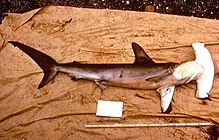Smooth hammerhead
| Smooth hammerhead | |
|---|---|

| |
| Scientific classification | |
| Domain: | Eukaryota |
| Kingdom: | Animalia |
| Phylum: | Chordata |
| Class: | Chondrichthyes |
| Subclass: | Elasmobranchii |
| Subdivision: | Selachimorpha |
| Order: | Carcharhiniformes |
| Family: | Sphyrnidae |
| Genus: | Sphyrna |
| Species: | S. zygaena
|
| Binomial name | |
| Sphyrna zygaena | |

| |
| Range of the smooth hammerhead | |
| Synonyms | |
* ambiguous synonym | |
The smooth hammerhead (Sphyrna zygaena) is a
The second-largest hammerhead shark after the
Taxonomy and phylogeny
The Swedish natural historian
| Phylogenetic tree of hammerhead sharks.[7] |
Studies based on
Description



The second-largest hammerhead next to the great hammerhead, the smooth hammerhead typically measures 2.5–3.5 m (8.2–11.5 ft) long, with a maximum recorded length and weight of 5 m (16 ft) and 400 kg (880 lb) respectively.[9] The smooth hammerhead differs from other large hammerheads in the shape of its cephalofoil, which has a curved front margin without an indentation in the center. The cephalofoil is wide but short, measuring 26–29% of the body length across. The nostrils are located near the ends of the cephalofoil, with long grooves running towards the center. There are 26–32 tooth rows in the upper jaw and 25–30 tooth rows in the lower jaw. Each tooth is triangular in shape, with smooth to weakly serrated edges.[9]
The body is streamlined, without a dorsal ridge between the two
Distribution and habitat
Of the hammerhead sharks, the smooth hammerhead is the species most tolerant of temperate water, and occurs worldwide to higher
Compared to the scalloped and great hammerheads, the smooth hammerhead stays closer to the surface, in water less than 20 m (66 ft) deep. However, it has been recorded diving to a depth of 200 m (660 ft). It prefers inshore waters such as
Biology and ecology

Adult smooth hammerheads are either solitary or form small groups. They may come together in great numbers during their annual migrations; schools of over a hundred juveniles under 1.5 m (4.9 ft) long have been observed off the eastern Cape of
The smooth hammerhead is an active-swimming predator that feeds on bony fishes, rays, sharks (including of its own species), cephalopods, and to a lesser extent
Like other hammerheads, the smooth hammerhead is viviparous: once the young exhaust their supply of
Human interactions
The smooth hammerhead is potentially dangerous to humans. As of 2008, the International Shark Attack File lists 34 attacks attributable to large hammerhead sharks, 17 of them unprovoked (1 fatal).[22] However, due to the smooth hammerhead's occurrence in temperate regions where people are less likely to enter the water, it was likely responsible for a minority of these attacks.[9] Off southern California, this species has been reported to steal catches from sport fishers and divers.[3]
Smooth hammerheads are caught by commercial fisheries throughout the world, including those off the
Many other fisheries from every ocean also take smooth hammerheads as bycatch, and they are caught in some numbers by recreational anglers. Smooth hammerheads are also killed by entanglement in shark nets used to protect beaches. Fewer than 10 smooth hammerheads were caught annually in the nets off KwaZulu-Natal, South Africa, from 1978–1990. In contrast, in the nets off New South Wales, Australia, smooth hammerheads comprised 50% of the 4,715 sharks captured from 1972–1990.[18] At present, this species remains relatively common and has been assessed as "Vulnerable (VU)" by the World Conservation Union.[1] Off New Zealand, it is a prohibited target species and is the most abundant shark along the northwest coast. In June 2018 the New Zealand Department of Conservation classified the smooth hammerhead as "Not Threatened" with the qualifier "Secure Overseas" under the New Zealand Threat Classification System.[23]
It also does not appear to have been negatively impacted by fishing off southern Australia.
References
- ^ . Retrieved 19 November 2021.
- ^ "Appendices | CITES". cites.org. Retrieved 2022-01-14.
- ^ ISBN 92-5-101384-5.
- ISBN 0-679-72210-6.
- ^ Aristotle (350 BCE). "Ch. XI.11". History of Animals (Book II)
- ^ a b Froese, Rainer; Pauly, Daniel (eds.) (2008). "Sphyrna zygaena" in FishBase. January 2008 version.
- ^ PMID 20138218.
- ^ Cavalcanti, M.J. (2007). "A Phylogenetic Supertree of the Hammerhead Sharks (Carcharhiniformes: Sphyrnidae)". Zoological Studies. 46 (1): 6–11.
- ^ a b c d e f g h i j k l Bester, C. Biological Profiles: Smooth Hammerhead. Florida Museum of Natural History Ichthyology Department. Retrieved on October 19, 2008.
- .
- ^ Kelly, B (21 July 2019). "Hammerhead shark spotted in Irish waters for the first time ever". Galway Daily. Retrieved 10 December 2019.
- Illustreret Videnskab. 9 February 2015. Retrieved 4 November 2017.
- ^ Carl, H.; J.G. Nielsen; P.R. Møller (2005). "En kommenteret og revideret oversigt over danske fisk". Flora og Fauna. 110 (2): 29–39.
- ^ Grace, M.; T. Henwood (1997). "Assessment of the Distribution and Abundance of Coastal Sharks in the U.S. Gulf of Mexico and Eastern Seaboard, 1995 and 1996". Marine Fisheries Review. 59 (4): 23–32.
- ^ ISBN 0-520-23484-7.
- .
- JSTOR 1446449.
- ^ ISBN 2-8317-0700-5.
- .
- .
- ISBN 0-7637-3313-X.
- ^ ISAF Statistics on Attacking Species of Shark. International Shark Attack File, Florida Museum of Natural History, University of Florida. Retrieved on May 18, 2009.
- OCLC 1042901090.
- ^ "CITES conference takes decisive action to halt decline of tropical timber, sharks, manta rays and a wide range of other plants and animals". Cites. 14 March 2013.

